245 vs 265 Tires: 5 Parameter Comparison Guide
Are you confused about choosing between 245 vs 265 tires for your vehicle? Finding the perfect car tires can be daunting, so we’re here to assist you. We understand the importance of selecting the right tire size for optimal performance.
Therefore, continue reading to learn about the key parameters that differentiate these two, like price, handling, acceleration, and so on. So, we’ll provide you with the necessary insights to make an informed decision. Let’s dive into it!
Table of Contents
245 vs 265 Tires: The Quick Comparison
Listed below table has all the essential details:
Quality | 245 Tires | 265 Tires |
Tire Width: | Wide tires | Wider tires |
Tire Height: | Large tires | Larger tires |
Comfort: | Less | Least |
Handling: | Good | Better |
Sidewall Height: | High | Higher |
Carload: | Medium load | Heavier load |
Braking distance: | Slightly longer braking distance | Short braking distance |
Rolling Resistance: | Lower | Higher |
Cost: | Cheap | Expensive |
245 vs 265 Tires: Key Characteristics of Two Car Tires
Let’s explore the characteristics of each tire size:
Characteristics of 245 Tire Size
Here are its top features:
- Enhanced Maneuverability: 245 tires improve handling and agility, allowing for better driving control and responsiveness.
- Better Traction: With a wider footprint, 245 tires offer excellent grip on the road, enhancing stability and safety, particularly on wet roads.
- Fuel Economy: Opting for 245 tires can improve fuel economy, saving you money at the pump.
- Comfortable Ride: The unique features of 245 tires result in a smoother and more comfortable driving experience, reducing vibrations and road noise.
- Aesthetic Appeal: Beyond their functional benefits, 245 tires add a stylish touch to your vehicle’s appearance, enhancing its overall aesthetic appeal.
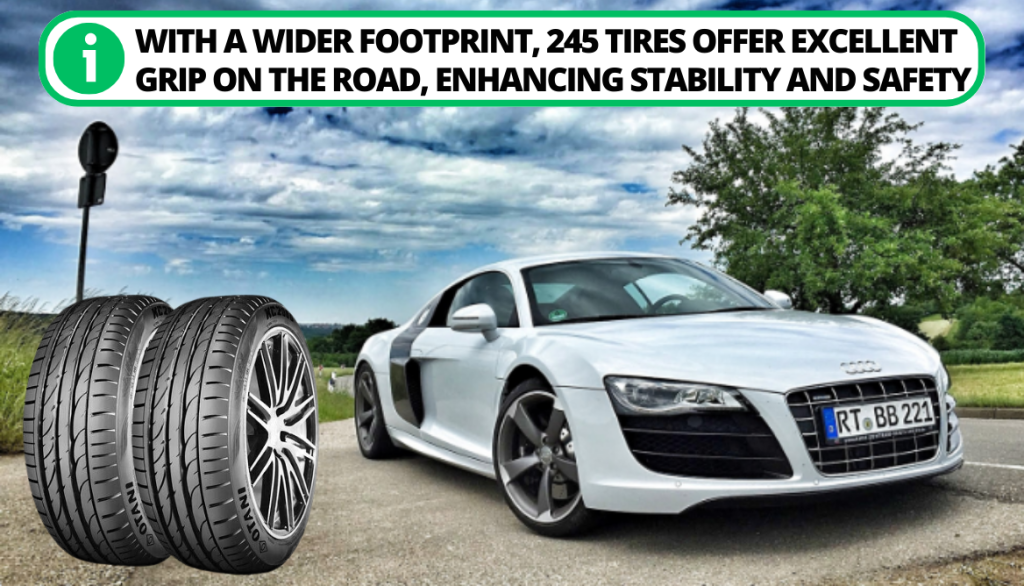
Characteristics of 265 Tire Size
Let’s find out the best features:
- Increased Tread Life: 265 tires often have a longer tread life than 245 tires, thanks to their wider tire width. This means they can provide more mileage before needing replacement, providing better value for money in the long run.
- Enhanced Load-Carrying Capacity: 265 tires can withstand heavier loads, making them ideal for larger vehicles or those frequently used for towing or hauling.
- Improved Stability at Higher Speeds: They offer enhanced stability and control due to their wider tires, particularly at higher speeds. This feature can benefit drivers who frequently travel on highways or enjoy a more spirited driving experience.
- Enhanced Cornering Performance: As larger tires, they provide a better grip with the road due to greater rim diameter, allowing better traction during turns and enhancing handling and confidence while maneuvering through curves.
- Off-Road Versatility: If you enjoy venturing off the beaten path, 265 tires excel in off-road environments. Their wide profile enhances traction and stability on rugged terrains, ensuring you can confidently tackle various off-road challenges.
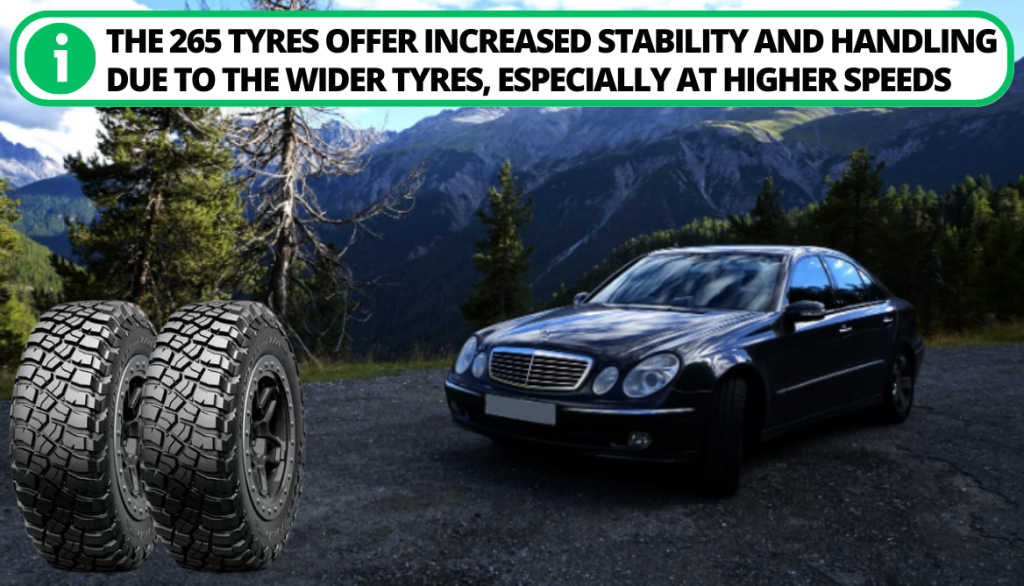
245 vs 265 Tires: What Set Them Apart?
Now, let’s explore the differences between these 2 tire sizes:
1. Price
245 ones are more affordable than 265 tires. However, it’s important to note that specific prices may vary based on tire brands, models, and retailers. Here’s why 245 is the more affordable of the two tires.
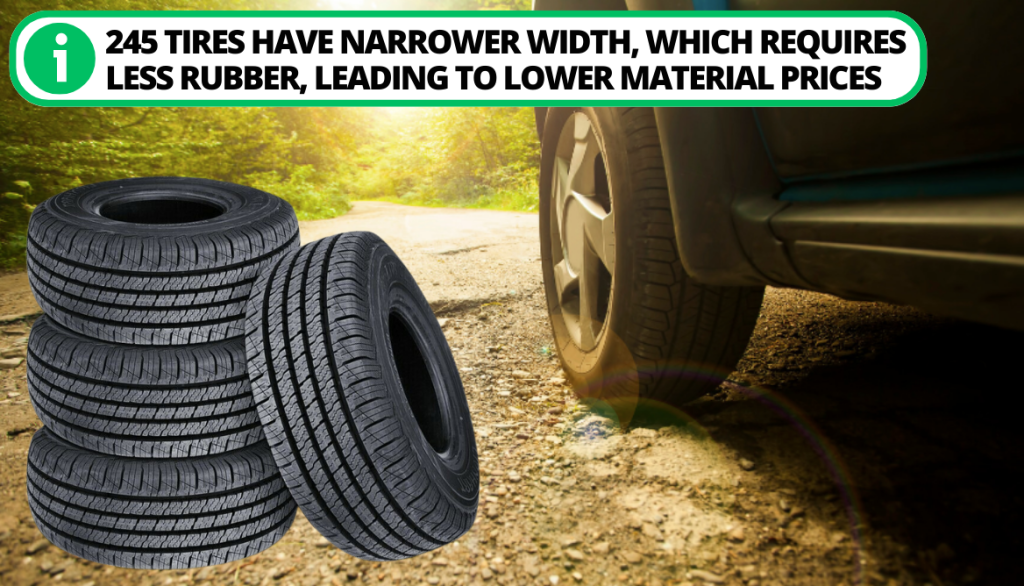
- 245 tires have narrower width, which requires less rubber, leading to lower material prices.
- They also use fewer materials with simple construction leading to lower manufacturing costs.
- As 245 tires are widely used in various vehicles, production volume increases, benefiting from economies of scale and potentially lower value.
- They provide reliable performance without extensive specialized features, resulting in a more budget-friendly price.
So, considering these factors, comparing other features like fuel consumption, aspect ratio, and rolling resistance is recommended before making a final decision.
2. Handling
Both 245 and 265 tires have outstanding handling characteristics. However, there are a few variances. 245, being a narrow tire offer superior responsiveness and agility. While its counterpart provides great stability while driving at high speeds due to its wider footprint.
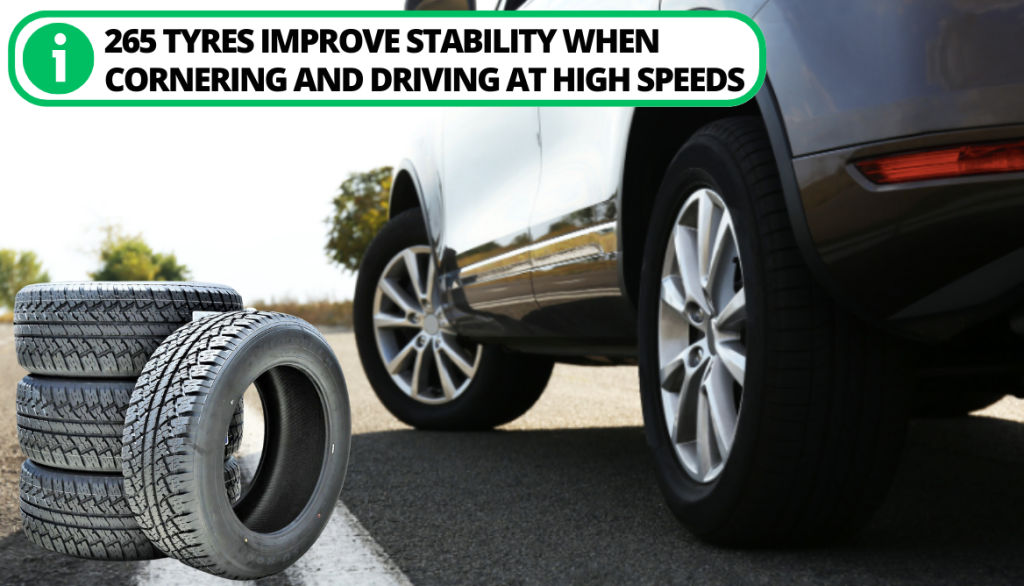
Listed below are the important facts:
- While 265 tires are less responsive because of their greater width, 245 tires have a quick steering reaction and high agility.
- When you drive at normal speed, 245 tires offer stability, whereas 265 tires improve stability when cornering and traveling at high speeds.
- 245 tires provide good grip on dry roads, while 265 on wet roads.
3. Acceleration
Regarding acceleration, 245 tires have a slight advantage. Their narrower width decreases rolling resistance, which results in quicker acceleration and better fuel economy.
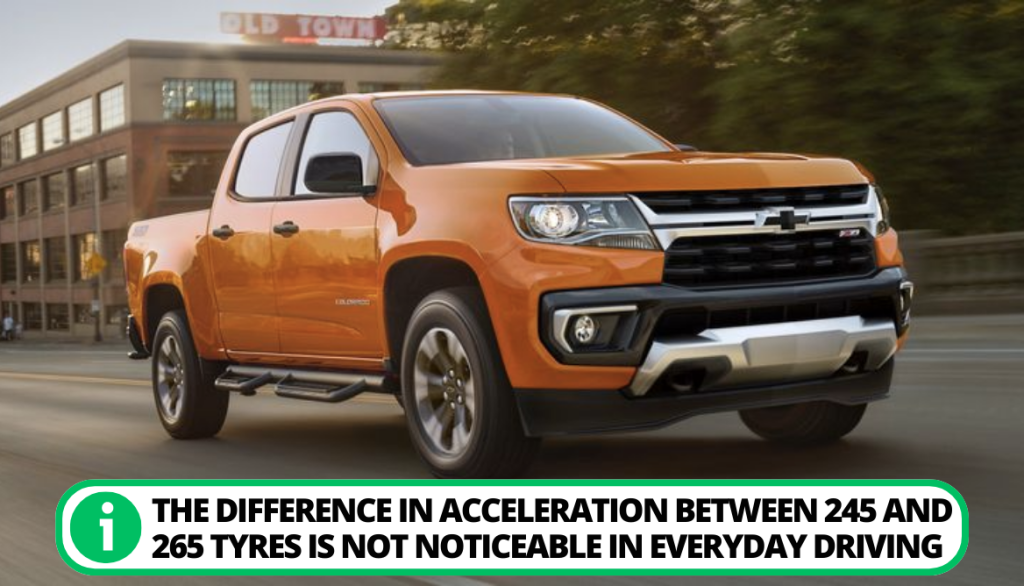
However, the difference in acceleration between 245 and 265 tires is minimal and may not be noticeable in everyday driving situations.
- 265 tires offer good responsiveness, but due to their wider width, they may be slightly delayed compared to 245 tires.
- The good traction of 245 tires allows for solid acceleration performance.
- The 265 tires’ wider footprint helps with efficient power distribution, which enhances acceleration.
4. Fuel Consumption
It is based on tire width and tire dimension. Let’s now compare the gas mileage between the two tires:
- Compared to 265 tires, 245 tires have narrower widths with lower rolling resistance, which reduces their gas mileage.
- In normal driving situations, 245 and 265 tires can both offer fuel-efficient performance.
- However, 245 tires offer superior fuel economy when driving normally.
- Additionally, 245 tires consume less fuel when you keep consistent driving patterns at sustained speed.
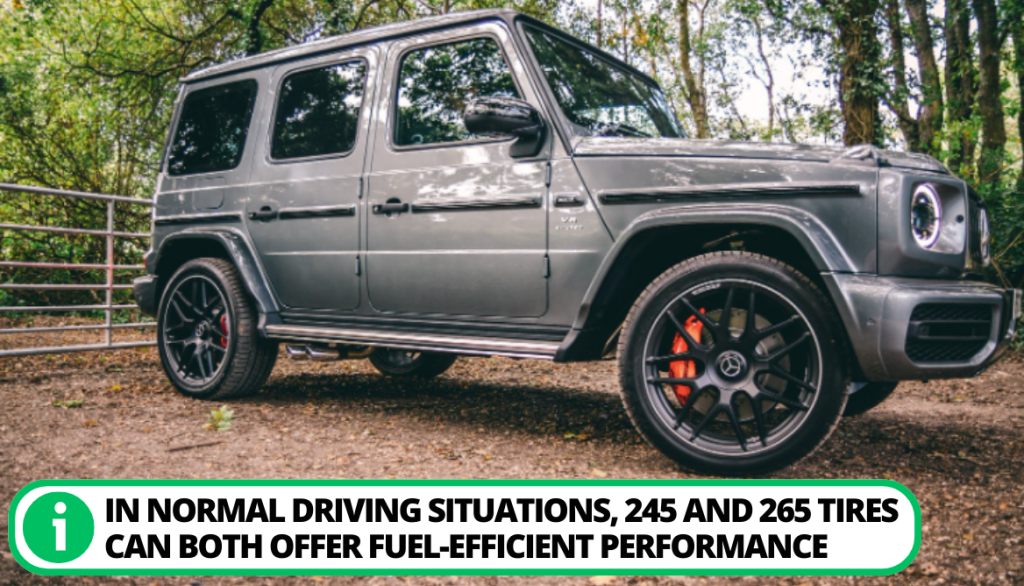
5. Comfort and Noise
The choice of tires can significantly impact the comfort and noise levels experienced during driving. Here is a quick comparison of the comfort and noise between 245 and 265 tires:
- Both 245 and 265 tires are capable of offering a smooth ride. However, comfort is determined by the rim diameter, tread pattern, and tire model.
- 245 tires offer a more comfortable ride by absorbing road irregularities with a solid suspension system.
- 265 tires have better noise-absorbing capacity. They include noise-canceling components in their tread pattern, which makes the ride quieter.
- Additionally, 245 tire models contain shock-absorbing technology that reduces road vibrations to a minimum.

245 vs 265 Tire Sizes: Limitations
While both 245 and 265 tires offer their own advantages, it’s important to consider their limitations as well. Here are some factors to keep in mind:
245 Tire Limitations
Listed below are some of the limitations of 245 tires:
1. Traction on Snow and Ice
245 tires might not offer the best traction in snowy or slippery situations due to their reduced width. They could not provide as much better traction and control as dedicated winter or snow tires, which are created with certain tread patterns and rubber compounds for improved winter performance.
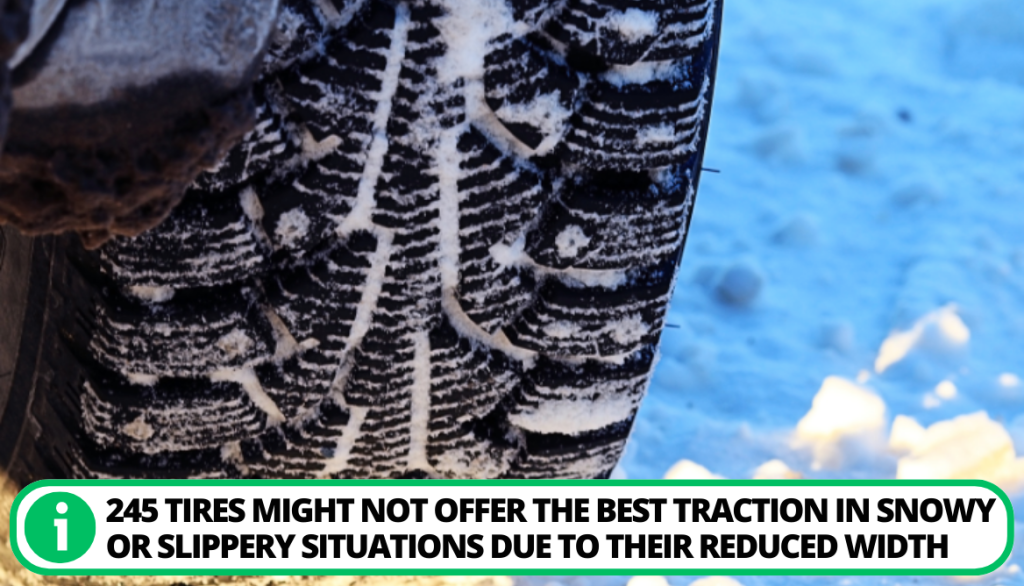
2. Stability in Certain Driving Conditions
Despite having limitations in terms of stability, especially when driving at high speeds or making sharp turns, 245 tires often offer acceptable handling and responsiveness. The smaller contact patch with the road due to the reduced width may have an impact on stability in some circumstances.
3. Off-Road Performance
The grip, longevity, and sidewall strength of 245 tires may be compromised if you frequently drive off-road or across rugged terrain. For these conditions, specialized off-road or all-terrain tires with more substantial tread blocks and reinforced sidewalls are preferable.
4. Load-Carrying Capacity
The load-carrying ability of 245 tires may be constrained depending on the particular tire model. Selecting tires capable of appropriately sustaining the load is vital if you frequently haul heavy loads or have a larger vehicle with higher weight needs.

5. Comfort on Rough Roads
245 tires typically offer a comfortable ride, they might not be able to adequately absorb road imperfections on harsh or badly maintained roads. The ride quality on rocky surfaces might be a little bit rougher due to the narrower width’s potential for a firmer ride than larger tires.
Considering these limitations are crucial for your driving experience. If you encounter any of these limitations frequently, in that case, explore alternative tire options that better align with your preferences.
265 Tire Limitations
Let’s dive into 265 tires limitations:
1. Maneuverability in Urban Driving
The width of these tires impacts maneuverability in tight urban environments, such as navigating narrow streets or parking in compact spaces. They may require more effort to turn compared to narrower tires.

2. Snow and Ice Traction
While wider tires can offer good traction in dry and wet conditions, they may have limitations in providing optimal traction on snowy or icy surfaces. Specialized winter or snow tires with specific tread patterns and rubber compounds are generally recommended for enhanced winter performance.
3. Fuel Efficiency
Due to their wider size, they may consume more fuel than narrower tires. However, advancements in tire technology have improved fuel economy, and the difference may be insignificant in some cases.
4. Potential for Hydroplaning
The wider footprint of 265 tires may increase the risk of hydroplaning in wet conditions, especially at higher speeds. Proper tread design and maintenance and adjusting driving behavior in inclement weather can help mitigate this risk.
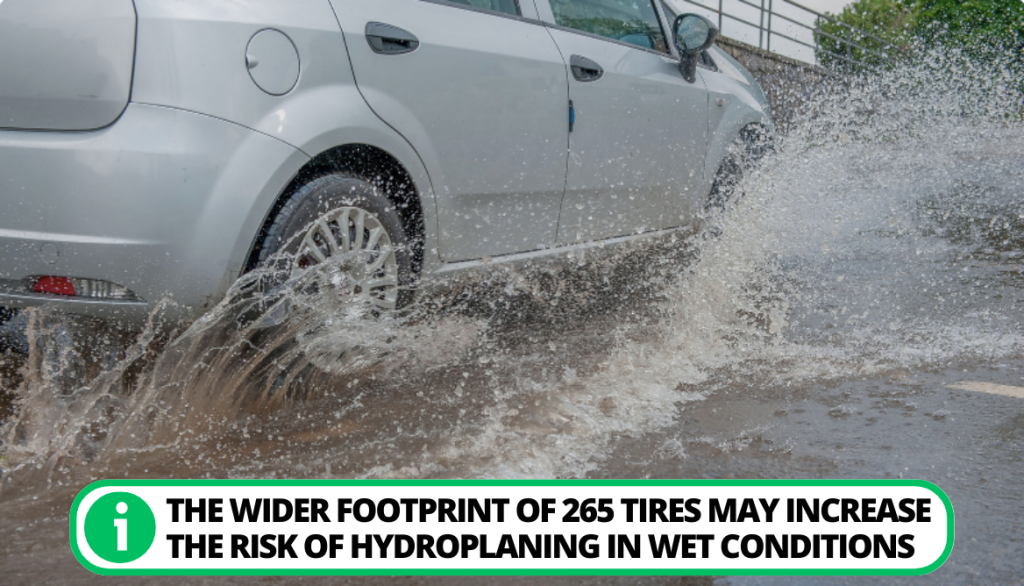
5. Road Noise
Some wider 265 tires, particularly those with more aggressive tread patterns, may generate more road noise than narrower tires. However, advancements in tire design have led to noise-reducing features that help minimize this issue.
6. Cost
Generally, 265 tires tend to be slightly more expensive than their narrower counterparts due to their wider size and increased material usage. It’s important to consider your budget and weigh the cost against the benefits you seek from the tires.
7. Clearance and Fitment
The wider size of 265 tires may pose clearance issues for certain vehicles, especially those with limited wheel well space or suspension setups. It’s essential to ensure proper fitment and compatibility with your vehicle to avoid any rubbing or interference.
Understanding these limitations can help you make an informed decision. However, it is important to note that both tires can be used on the same axle of the wheel. Having the same axle means that both tires can be mounted on the same side, either on the front or rear wheels. But remember, having the same rolling radius is essential.
To lay your hands on the correct wheels, you should check out this helpful video.
FAQ
Can I go from 265 to 245 tires?
Yes, you can switch from 265 tires to 245 tires, but there are a few factors to consider. First, you need to check if the tire size is compatible with your vehicle’s rim width. Additionally, keep in mind that the switch may affect your vehicle’s handling characteristics, so it’s important to consult a professional for guidance.
Are 245 tires wide?
Yes, 245 tires are wide, as the number ‘245’ represents the tire’s width in millimeters. However, they are not wider than 265 tires.
Is a 245 tire better than a 235?
Whether a 245 tire is better than a 235 tire depends on individual preferences and requirements. Usually, 245 tires offer wider contact and better handling, while 235 tires offer better fuel consumption and a smoother ride.
Does tire size affect distance?
Larger wheels decrease the distance required to brake, whereas smaller wheels necessitate a longer stopping distance. A shorter braking distance is considered preferable, as it enhances safety. So, 245 tires will require less distance than 265 tires.
Are bigger tires worth it?
Bigger tires are worth it, as they offer improved performance, handling, and aesthetics. But they also have drawbacks, such as increased cost, more fuel, and compatibility issues.
Conclusion
Summing it up, both tires have their positives and negatives. 245 tires offer improved maneuverability, traction, better grip, and comfort, whereas 265 has better tread life, greater speeds, and off-road adaptability. Both tires are worth it, and choosing between the two boils down to your personal preferences.
Moreover, when getting a new tire, you must consult a trusted mechanic for the size that matches your car model. Additionally, you need to consider your driving speeds.
So, which tire are you getting for your vehicle? Let us know in the comments!

I`m a current Law Enforcement Officer working within the Counterterrorism Bureau in New York State. I have been Camping for over 20 years. My styles of camping include tent, car, truck, van, and RV travel trailer. I have a YouTube channel where I teach all types of camping with an entertaining method: https://youtube.com/@TheSmallsRVAdventures

![Top 8 Best RV Batteries [Buying Guide]](https://camperlife.co/wp-content/uploads/2021/04/best-rv-battery.png)

![Top 15 Best TVs for RV [Buying Guide]](https://camperlife.co/wp-content/uploads/2021/03/best-tv-rv.png)

![Top 8 Best RV Battery Monitors [Buying Guide]](https://camperlife.co/wp-content/uploads/2021/02/best-rv-battery-monitor-768x447.jpg)
